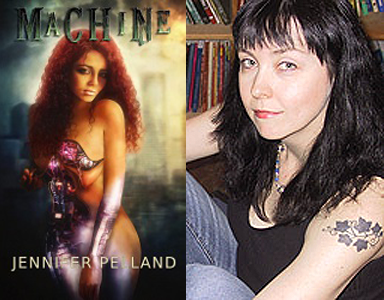I don’t know about you, but I always want to know what a new indie press is going to offer to this readerly world, what new lit stakes they will be touting with their first set of titles. SpringGun Press, run by Mark Rockswold and Erin Costello, has been a journal since 2009, but now has several print titles of both fiction and poetry, including Lily Ladewig’s The Silhouettes – a charming poetic collection that sings of bodies and fragments, and that we feel lucky to ask after for a bit here.
MB: As we mentioned above, SpringGun Press is relatively new to the print scene, so can you share with us a little about the process that The Silhouettes went through from selection to release with SpringGun?
 LL: I submitted to SpringGun’s first open reading period in June. I had enjoyed reading their journal — they published a lot of writers who I really respected (Kate Greenstreet, Brian Foley, Nate Pritts, etc.) and the design is always smart and little cheeky. In September Erin and Mark emailed me to tell me they wanted to publish my book. I emailed back and forth with them and immediately felt comfortable working with them. I knew that we were on the same page in terms of what we wanted for the book and we worked together on reshaping the manuscript. I think it’s natural to be a little nervous about how a book will turn out when working with a new press, but for the most part I was really excited that we would be embarking on this together. It was a very collaborative process.
LL: I submitted to SpringGun’s first open reading period in June. I had enjoyed reading their journal — they published a lot of writers who I really respected (Kate Greenstreet, Brian Foley, Nate Pritts, etc.) and the design is always smart and little cheeky. In September Erin and Mark emailed me to tell me they wanted to publish my book. I emailed back and forth with them and immediately felt comfortable working with them. I knew that we were on the same page in terms of what we wanted for the book and we worked together on reshaping the manuscript. I think it’s natural to be a little nervous about how a book will turn out when working with a new press, but for the most part I was really excited that we would be embarking on this together. It was a very collaborative process.
Something that was also really appealing about SpringGun is that all of their covers are created by artists in direct response to the book. Erin was assigned to my book and she’s a really talented graphic designer. She had spent a lot of time with the poems and also had me fill out a questionnaire asking about my thoughts on the aesthetics of the cover. I knew I didn’t want it to be a typical side-profile portrait, but I wanted something that alluded to and deconstructed the traditional silhouette. She sent me six options, all of which were great, and we went back and forth between two, ultimately deciding on the current cover. I am incredibly happy with how it turned out — Erin’s cover design is exactly what I had envisioned, and Mark’s layout really highlights the poems. I’m super proud to be one of their first authors, along with Adam Peterson, Joe Hall, and Chad Hardy.
MB: Moving into the collection itself, the ‘body’ is heavily invoked throughout The Silhouettes. For instance, ‘I Put a Body On’:
Like a clever bride
keeping
her skeleton
key close at hand,
reassembling.
I put honey on my body.
Or, in ‘Husbands & Other Seasons’:
I’ve always thought weekends were the worst.
What to do
with myself. With my hands
at the gallery opening.
Can you talk to us about where this focus on the body or body parts comes from and how it features in your writing process?
LL: I think my preoccupation with the body partly stems from being a dancer for most my adolescence. From the age of three to sixteen I took ballet classes and I still love going to dance performances, especially contemporary troupes like Mark Morris, Shen Wei Dance Arts, and Merce Cunningham. Wim Wenders 3-D film documentary on the choreographer Pina Bausch was the most incredible and inspiring movie that I saw this past year!
In college I was a member of the Tufts mime troupe, which was an amazing creative experience because we were able to evoke stories and emotions for the audience without the use of words, props, sets, or costumes. I have always been interested in using body movement as a form of communication; gesture (both physically and linguistically) is a means of storytelling that can blur the line between literal and figurative interpretation.
Similarly, around the time I started writing the poems that are in this book, I received my certification to teach yoga. This posed a different challenge because I was now called upon to instruct students on how to move through verbal cues: ‘Inhale the right leg up and back, exhale and draw the knee to the chest, place the right foot between the hands and lift your arms overhead, open the heart and spread the fingers…’ In a sense it was the opposite of the performances I’d done in the past. I had to find new ways of articulating body movement through language, which was both fascinating and surprisingly complicated.
Finally, bodies are sexy and they are at the center of all of my love poems.
MB: There is also a second person ‘you’ addressed throughout the poems in this book. Who is this person and where does he/she manifest from?
LL: Every poem in this collection was written with a specific ‘you’ in mind. For the most part they were written to people I have been involved with romantically, but in some cases these poems were also written to friends. For example, the last poem in the book, ‘Apologia’, I started to write to Anne Cecelia Holmes who was subletting my bedroom for the summer. I actually began writing it as though I was giving her instructions and warnings about living in my house (and a lot of it was true, like the skunks and the arsonist who had terrorized the neighborhood the year before) but then, halfway through, the poem took on a life of its own and it turned into a kind of spooky ghost story. I surprised myself with it.
Saying this makes me feel a little like a magician giving away her tricks. I hope this doesn’t ruin any mystery for readers but that’s the truth of it. I encourage people to consider the ‘you’ to as consistent person, or to imagine that I’m addressing them directly throughout.
MB: Both the ‘Shadow Box’ and the ‘On Silhouettes’ pieces are threaded throughout The Silhouettes, so I’m curious if you view this book as a collection of poetry or as a poetic narrative, meant to be read altogether as well as separately?
 LL: That’s a really great question. This book began as my MFA thesis, and the UMass program requires everyone to write a brief introduction for our defense. I wrote mine as a treatise on ‘silhouette’, giving a history of the word (it derives from the name of an 18th century financial minister in France, Étienne de Silhouette), and discussing how shadows and outlines relate to fashion and my thoughts on poetry. The ‘On Silhouettes’ poems stem from this essay and function as a kind of thesis for the book.
LL: That’s a really great question. This book began as my MFA thesis, and the UMass program requires everyone to write a brief introduction for our defense. I wrote mine as a treatise on ‘silhouette’, giving a history of the word (it derives from the name of an 18th century financial minister in France, Étienne de Silhouette), and discussing how shadows and outlines relate to fashion and my thoughts on poetry. The ‘On Silhouettes’ poems stem from this essay and function as a kind of thesis for the book.
Originally the ‘Shadow Box’ poems were grouped all together and I considered them to be one long poem. I wrote nine of them in the span of a couple of days in the spring of 2009. Leigh Stein asked me if I would participate in one of her Poets & Puppets reading so I thought it was be fun to build a little shadow puppet theater to accompany the poems. A couple of friends who come to the reading encouraged me to write more, and I wrote another seven over the course of a week in early summer 2011. When I began revising the book with Mark and Erin, they suggested breaking them apart and mixing them throughout the rest of the book. At first I wasn’t sure if I wanted to do this because I saw the ‘Shadow Boxes’ as a distinct story with a real beginning, middle, and end. However, in spreading them throughout the book, this had the wonderful effect of giving the entire book an overarching narrative.
MB: ‘silhouettes’ also carry in both the series ‘On Silhouettes’:
When Peter Pan’s shadow misbehaves
Wendy must sew it back onto his heels
with a needle and thread. As a fashion term
a silhouette has as much to do with the cut
and shape of a garment as it does with the body
and are embedded in others, like ‘Good Winter’:
I am none of these winters.
I am the silhouettes
of two girls
in black coats clicking
down a Roman side street.
To wrap up this interview, can you talk with us about the importance of the silhouette as a recurring image or theme throughout this book?
LL: It’s interesting that you point to ‘Good Winter’ because that was the first poem I wrote that had the word ‘silhouette’ in it and it’s from this poem that I pulled the title for the book. I love the glamour of fashion and the idea of building a persona through clothing and costume. I read a lot of fashion blogs, and one of my favorites is The Sartorialist, which features candid photographs of street fashion. A few years ago I came upon a beautiful shot of two women wearing dynamic black coats, black stockings, and black high heels. They looked like two walking shadows, mirroring each other.
On a more theoretical note, what makes a silhouette so appealing to me is its inherently ambiguous nature. I find art and poetry to be the most effective when it inhabits a shadowy space, when we are given hints of narrative or persona but our responses are not explicitly dictated. I am interested in the shape of a poem—not only the formation of black ink set against the white space of the page but also the effect that imagery and syntax has on the mind of the reader. I like poems that are evocative – when the poet gives us clues, or outlines, and then we have to fill in the blank with our own ideas and memories.
If you want to silhouette us here at Monkeybicycle, get yourself a copy of this book and read it on one of these springish days in a study of SpringGun Press’s evolution – a press we will no doubt have more interviews from very soon. In the meantime, get yourself a copy of The Silhouettes from SpringGun Press here, & read more from / about Lily Ladewig here.



